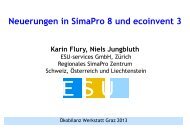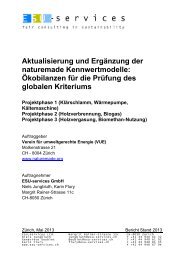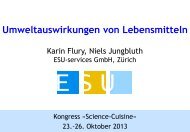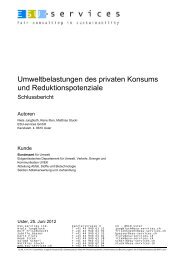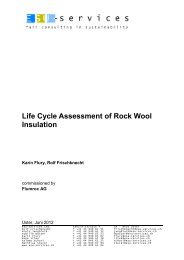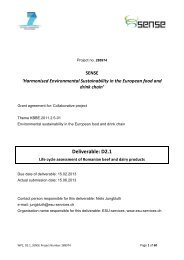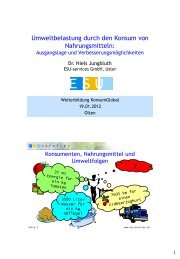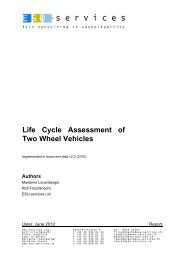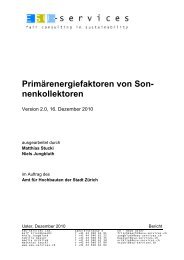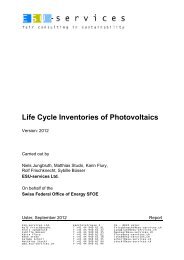Life-Cycle-Assessment for Stoves and Ovens - ESU-services Ltd.
Life-Cycle-Assessment for Stoves and Ovens - ESU-services Ltd.
Life-Cycle-Assessment for Stoves and Ovens - ESU-services Ltd.
You also want an ePaper? Increase the reach of your titles
YUMPU automatically turns print PDFs into web optimized ePapers that Google loves.
3 Impact <strong>Assessment</strong><br />
In this chapter the results of the life-cycle assessment <strong>for</strong> the various cooking alternatives investigated<br />
are presented <strong>and</strong> analyzed. The classification used is explained. Firstly all alternatives<br />
are compared. The influence of the efficiency on the environmental impact scores <strong>and</strong><br />
the values <strong>for</strong> the Eco-indicator 95+ are investigated in detail. This is followed by a more detailed<br />
analysis of the results <strong>for</strong> the calculation of Eco-indicators 95+ <strong>and</strong> the contribution of<br />
different stages in the life-cycle <strong>for</strong> the total results. The results of the calculation <strong>for</strong> Ecoindicators<br />
95+ are shown in Tab. 22 of annex 6.2. The impact score profile is given <strong>for</strong> 23 environmental<br />
impact categories in annex 6.2, Tab. 23. The results of the life-cycle-inventoryanalysis<br />
<strong>for</strong> all environmental impacts investigated are given in Annex 6.5, Tab. 24.<br />
3.1 Categories <strong>for</strong> the Impact <strong>Assessment</strong><br />
There are different concepts to conduct the impact assessment in an LCA. They can be distinguished<br />
in fully <strong>and</strong> partly aggregated models. A good overview <strong>for</strong> the state of the art is<br />
given <strong>for</strong> example by Braunschweig et al. (1996). (Heijungs et al. 1992a) developed a concept<br />
<strong>for</strong> the classification of different environmental impacts to impact categories. Developing the<br />
concept <strong>for</strong> the Eco-indicator 95, Goedkoop (1995) improved <strong>and</strong> extended this approach. A<br />
description of this method is given in annex 6.1. Tab. 14 shows the effects distinguished in<br />
the two reports.<br />
Twenty-three categories of environmental impact categories are distinguished in the calculation<br />
with ECOINVENT. These impact categories describe different environmental hazards or<br />
problems often considered while discussing about environmental themes, e.g., global warming,<br />
use of resources, etc. But some of these categories describe effects overlapping because<br />
they where adopted from different methods or they describe the same effect in a different<br />
time horizon. The third column of Tab. 14 gives the effects implemented in the database<br />
ECOINVENT. The last column of the table gives a short description of the different environmental<br />
impacts.<br />
For this report the calculation of Eco-indicators 95 <strong>for</strong> nine environmental impacts as described<br />
in annex 6.1 has been implemented in the database ECOINVENT. The advance <strong>for</strong><br />
the implementation is described in the Annex 6.2. The inclusion is linked with a few changes<br />
of the original method. This approach is used <strong>for</strong> evaluation in this report <strong>and</strong> named as Ecoindicator<br />
95+. Except pesticides 21 , environmental effects as distinguished by Goedkoop<br />
(1995), are included in this approach.<br />
But the method Eco-indicator 95+ does not give a good picture of all environmental impacts<br />
of electricity production based on hydro- <strong>and</strong> nuclear power in Switzerl<strong>and</strong> <strong>and</strong> there<strong>for</strong>e<br />
yields to misleading results.<br />
Thus the actual investigation will look on some additional impact categories calculated in<br />
ECOINVENT <strong>and</strong> not included in the concept of Eco-indicator 95+. The impact categories<br />
radioactivity, space use, waste heat (as an indicator <strong>for</strong> the use of energy resources) <strong>and</strong> eoctoxicity<br />
are used <strong>for</strong> the valuation. The Eco-indicator 95+ does not give a picture of the first<br />
three effects. Waste heat might not be as important <strong>for</strong> the environment, but this impact category<br />
is used here as an indicator <strong>for</strong> non-renewable energy resources. Some heavy metals do<br />
21 Up to now, pesticides were not included in the database ECOINVENT because they do not play a role <strong>for</strong> the<br />
processes investigated so far.<br />
- 16 -



